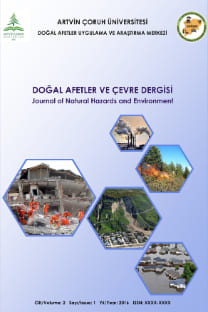Perde-Çerçeve Sistemlerde Rijitlik ve Kayma Merkezi
Center of Rigidity and Center of Shear in Wall-Frame Systems
___
- Bakas N., (2017), Shear forces amplification due to torsion, explicit reliance on structural topology, Theoretical and numerical proofs using the Ratio of Torsion (ROT) concept, Structural Engineering and Mechanics, 61(1), 15-29.
- Basu S., Jain S.K., (2007), Alternative method to locate centre of rigidity in asymmetric buildings, Earthquake Engineering and Structural Dynamics, 36(7), 965-973.
- Bilyap S., (1979), Betonarme yüksek yapılarda perde çerçeve sistemlerinin yatay kuvvetlere göre hesabı, Ege Üniversitesi Matbaası, İzmir.
- Bilyap S., Ertutar Y., Alku Ö.Z., (1987), Perde-çerçeve sistemlerinde burulma etkileri, Dokuz Eylül Üniversitesi MühendislikMimarlık Fakültesi Yayınları MM/İNŞ-87 EY 131, İzmir.
- Bozdogan K.B., Öztürk D., (2010), An approximate method for lateral stability analysis of wall-frame buildings including shear deformations of walls, Sadhana, 35(3), 241-253.
- Cheung V.W.T., Tso W.K., (1986), Eccentricity in irregular multistory buildings, Canadian Journal of Civil Engineering, 13(1), 46- 52.
- Çakıroğlu A., Özmen G., Özer E., (1978), Betonarme sistemlerin yatay yüklere göre projelendirilmesi, İMO İstanbul Şubesi, Kazmaz Matbaası, İstanbul.
- Çelebi Ü., (1990), Burulma yapan çok katlı perde-çerçeve sistemlerinin yatay yüklere göre hesabı için iki ayrı yeni yöntem, Doktora Tezi, Dokuz Eylül Üniversitesi Fen Bilimleri Enstitüsü, İzmir.
- Çelebi Ü., Bilyap S., (1991), Burulmalı Perde-Çerçeve sistemlerinin hesabında sürekli burulma çubuğu analojisi yöntemi, Türkiye İnşaat Mühendisliği 11. Teknik Kongresi Bildiriler Kitabı Cilt 1, 8-11 Ekim, İstanbul. ss.62-73.
- Doudoumis I.N., Doudoumis N.I., (2017), Centres of rigidity in multi-storey asymmetric diaphragm systems for general lateral static loading, Engineering Structures, 150, 39-51.
- Ertutar Y., (1995), Betonarme yüksek yapılarda yatay yük etkisi, Dokuz Eylül Üniversitesi Yayınları, İzmir.
- Ertutar Y., (1997), Yatay kuvvetler etkisindeki perde-çerçeve sistemlerinin burulmalı çözümü, Yeni Deprem Yönetmeliği ve Uygulama Sorunları Sempozyumu Bildiriler Kitabı, 33-39, İzmir.
- ETABS, (2019), Structural Software for Building Analysis and Design, Evaluation Version, https://www.csiamerica.com/products/ etabs, [Erişim 15 ocak 2019].
- Goel R.K., Chopra A.K., (1993), Seismic Code Analysis of Buildings without Locating Centers of Rigidity, Journal of Structural Engineering, 119(10), 3039-3055.
- Georgoussis G.K., (2010), Modal rigidity center: it's use for assessing elastic torsion in asymmetric buildings, Earthquakes and Structures, 1(2), 163-175.
- Haque A., (2017), Approximate Lateral Deflection of Moment-Resisting Frames,Yayınlanmamış Notlar.
- Hejal R., Chopra A.K., (1989), Earthquake response of torsionally coupled Frame buildings, Journal of Structural Engineering, 115(4), 852-867.
- Kılar V., Fajfar P., (1997), Simple Pushover Analysis of Asymmetric Buildings, Earthquake Engineering and Structural Dynamics, 26, 233-249.
- Yiu C.F., Chan C.M., Huang M., Li G., (2014), Evaluation of lateral-torsional coupling in earthquake response of asymmetric multistory buildings, The Structural Design of Tall and Special Buildings, 23(13), 1007-1026.
- Makarios T., Anastassiadis K., (1998a), Real and fictitious elastic axes of multi-storey buildings: theory, The Structural Design of Tall Buildings, 7(1), 33-55.
- Makarios T., Anastassiadis K., (1998b), Real and fictitious elastic axes of multi-storey buildings: applications, The Structural Design of Tall Buildings, 7(1), 57-71.
- Marino E. M., Rossi P.P., (2004), Exact evaluation of the location of the optimum torsion axis, The Structural Design of Tall and Special Buildings, 13(4), 277-290.
- Makarios T.K., (2005), Optimum torsion axis to multistorey buildings by using the continuous model of the structure, The Structural Design of Tall and Special Buildings, 14(1), 69-90.
- Murashev V., Sigalov E., Baikov V.N., (1976), Design of reinforced concrete structures, Mir Publishers, Moscow, 596 ss.
- Özmen G.,(1972), Burulma yapan çok katlı yapıların yatay yüklere göre hesabı, İTÜ İnşaat Fakültesi,Teknik Rapor No:13, İstanbul.
- Özmen G., Girgin K., Durgun Y., (2014), Torsional irregularity in multi-story structures, International Journal of Advanced Structural Engineering, 6(4), 121-131.
- Potzta G., Kollar L.P., (2003), Analysis of building structures by replacement sandwich beams, International Journal of Solids and Structures, 40(3), 535-553.
- Rafezy B., Howson W.P., (2009), A New and Practical Approach for Calculating the Static Eccentricity of Doubly Asymmetric, Nonproportional, Multi-storey Buildings, Proceedings of the World Congress on Engineering’in İçinde, (Alterman R., Kirsh D., Ed.), London, U.K.
- Wilkinson S., Thambiratnam D., (2001), Simplified procedure for seismic analysis of asymmetric buildings, Computers & Structures, 79(32), 2833-2845.
- Zalka K., (2001), A simplified method for calculation of the natural frequencies of wall–frame buildings, Engineering Structures, 23(12), 1544-1555.
- ISSN: 2528-9640
- Yayın Aralığı: 2
- Başlangıç: 2015
- Yayıncı: Artvin Çoruh Üniversitesi Doğal Afetler Uygulama ve Araştırma Merkezi
Perde-Çerçeve Sistemlerde Rijitlik ve Kayma Merkezi
Kanat Burak BOZDOĞAN, Süleyman AYDIN
Bingöl İl Merkezinde Taşkın Yayılım Alanlarının Coğrafi Bilgi Sistemleri ve HEC-RAS ile Belirlenmesi
Murat ÇELİKLER, Nilüfer NACAR KOÇER, Osman YILDIZ
Termal Uzaktan Algılama Görüntüleri İle Yüzey Sıcaklıklarının Belirlenmesi: Kocaeli Örneği
Uluabat Gölü Noktasal Kirletici Kaynaklar ve Kirlilik Yükleri
Saadet HACISALİHOĞLU, Feza KARAER
Yusufeli Barajı Antropojenik Etkilerinin Peyzaj Planlama Açısından Değerlendirilmesi
Orman Yangın Yönetiminde Etkili Bir Karar Destek Sisteminin Kavramsal Çerçevesi
KADİR ALPEREN COŞKUNER, Ertuğrul BİLGİLİ
Taşkın Frekans Analizinde Eşik Üstü Pikler Yönteminin Seyhan Havzası’nda Uygulanması
Yerdeğiştirme Tabanlı Deprem Erken Uyarı Sistemleri
